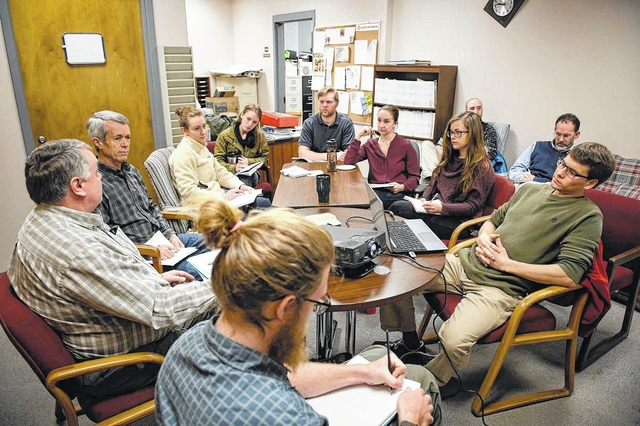
CLEMSON — Clemson University professors John Rodgers and James Castle will let the politicians and interest groups fight over the route of the proposed Keystone XL pipeline while they and their graduate students toil away in a basement laboratory solving a much more vexing problem: how to clean the virtual flood of water needed to extract billions of barrels of oil from the sands of the Western Canadian Sedimentary Basin.
Clemson team
There are an estimated 1.7 to 3.5 billion barrels of oil in the form of bitumen 50 to 75 meters under the surface of the ground in Alberta, Canada. To extract the bitumen, the oil sands are dug up in huge chunks, crushed, mixed with water and turned into slurry. The oil then is collected and the water is put into holding ponds to be used again and again in the extraction process.
Canadian law requires that each section of a mining company’s lease be returned to a state equivalent to what it was before mining began. All that mining water, loaded with hydrocarbons, has to be cleaned before it can be released back into Lake Athabasca – the eighth largest lake in Canada – and its tributaries.
Over the next two years, the Clemson team will design a series of experiments to identify toxic materials in the oil sands mining water, determine environmentally acceptable levels of those toxic materials and engineer a constructed wetland treatment system that will use plants and soil to trap, transfer and transform potentially toxic inorganic elements from water used in the oil sands mining process.
“We’re putting biochemistry to work in a targeted way,” Rodgers said. “There are reactions that happen in wetlands that don’t happen in any other ecosystems. You can use those reactions to transform and transfer constituents or to make them less toxic.”
It’s a big project, but one that Rodgers believes he and his team are ready to tackle.
“We looked around and saw that there was an incredible mess brewing in Alberta and decided we have to help solve it,” Rodgers said.
Rodgers and Castle lead a cohort of hydrology and wildlife and fisheries biology graduate students that include Andrew McQueen of Monroe, Louisiana; Kyla Iwinski of Marquette, Michigan; Tyler Geer of Clemson; Kayla Wardlaw of Clemson; Alyssa Calomeni of Albany, New York; Daniel Gaspari of Charlotte, North Carolina; Ciera Kinley of Scranton, Pennsylvania; Rebecca Kiekhaefer of Midland, Michigan; and Samuel Muller of Cumming Georgia.
More than 80 Clemson graduate students have worked over the years designing constructed wetlands to clean toxic water across the globe from the Savannah River Site in South Carolina to the Central Africa Republic of Chad.
“We treat our students like they’re colleagues. We want them to be ready to take on the next big environmental problems, so we push each other hard,” Rodgers said.
Phil Dorn, Shell Oil Company ecotoxicology manager, has worked closely with Clemson on several industry-funded clean up projects over the years.
“Clemson students are top notch and they’re fortunate to be working with some of the top environmental scientists in the world,” Dorn said. “John tells them if they want to have an impact on the world, they need to work on problems that people really care about, and they get to take on pivotal roles in projects that solve real-world problems.”
McQueen, a graduate research assistant and Ph.D. student, has seen firsthand the restorative powers of wetlands. He was on a team that helped clean the aftermath of the 2010 Deep Horizon oil spill and he’s taken on the Canadian oil sands clean up as his doctoral dissertation.
“The Lake Athabasca and Fort McMurray region already contain a lot of native wetlands, so a constructed wetland engineered to clean the specific constituents left behind by the mining process makes sense as a solution,” McQueen said.
Long-term plans call for returning the Alberta mining lands to a stable biologically self-sustaining state by creating a mosaic landscape dominated by productive forests, wetlands areas alive with waterfowl and grasslands supporting grazing animals.
Constructed wetland treatment systems are proven to be effective at cleaning water, but each must be custom-designed to handle specific toxic materials and amounts of water.
Years ago, Rodgers and a team of graduate students were called upon to design a system that could clean 1 million gallons per day of toxic water flowing from waste streams and stormwater flows at the Savannah River Site. The water contained metals such as copper, lead, mercury and zinc.
After prototyping and testing, Rodgers and his students designed a retention basin to manage the stormwater runoff and a series of eight constructed wetland treatment areas capable of regulating 22 million gallons of stormwater.
“There were streams at the Savannah River Site with no invertebrate or fish life. Now years later, our students can be proud that fish are fighting to get in that water because it’s so clean,” Rodgers said.

